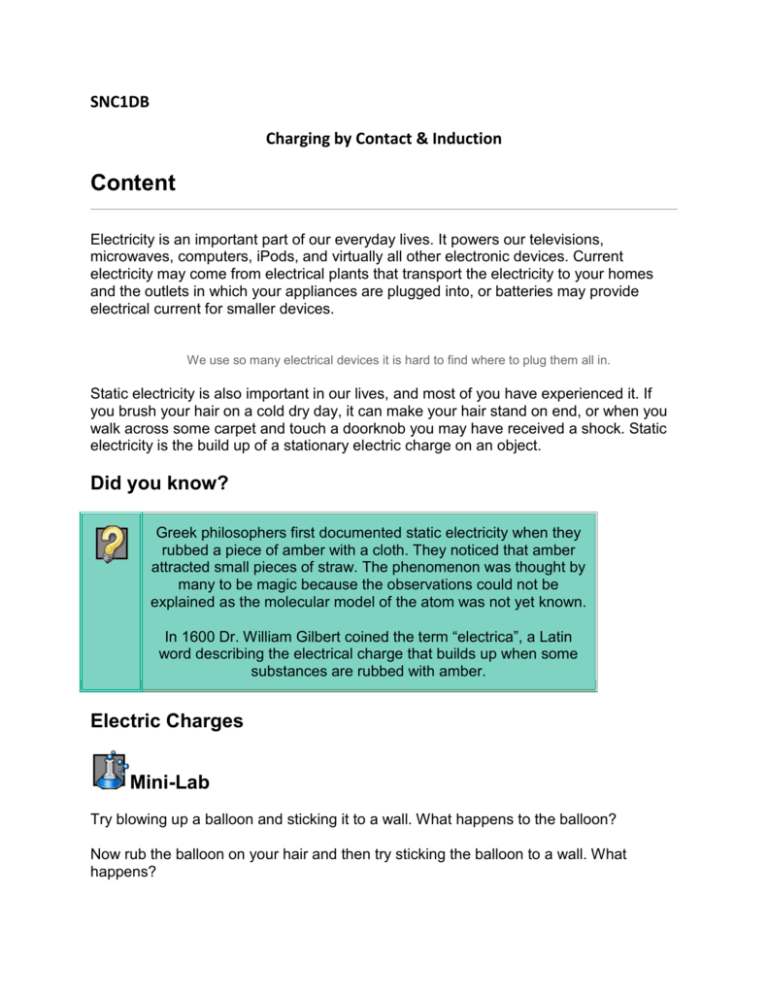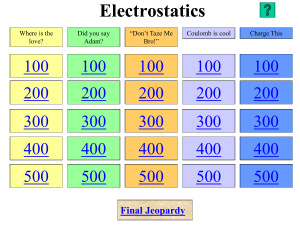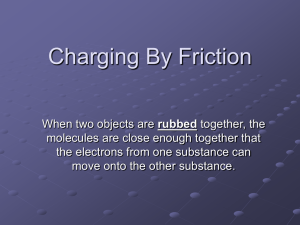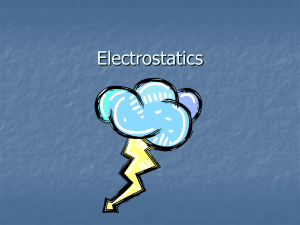Day 5 - Charging by Contact & Induction
advertisement

SNC1DB Charging by Contact & Induction Content Electricity is an important part of our everyday lives. It powers our televisions, microwaves, computers, iPods, and virtually all other electronic devices. Current electricity may come from electrical plants that transport the electricity to your homes and the outlets in which your appliances are plugged into, or batteries may provide electrical current for smaller devices. We use so many electrical devices it is hard to find where to plug them all in. Static electricity is also important in our lives, and most of you have experienced it. If you brush your hair on a cold dry day, it can make your hair stand on end, or when you walk across some carpet and touch a doorknob you may have received a shock. Static electricity is the build up of a stationary electric charge on an object. Did you know? Greek philosophers first documented static electricity when they rubbed a piece of amber with a cloth. They noticed that amber attracted small pieces of straw. The phenomenon was thought by many to be magic because the observations could not be explained as the molecular model of the atom was not yet known. In 1600 Dr. William Gilbert coined the term “electrica”, a Latin word describing the electrical charge that builds up when some substances are rubbed with amber. Electric Charges Mini-Lab Try blowing up a balloon and sticking it to a wall. What happens to the balloon? Now rub the balloon on your hair and then try sticking the balloon to a wall. What happens? In the mini-lab above the balloon initially did not stick to the wall, however after rubbing it on your hair it did stick to the wall. Why did this happen? Atomic structure of a helium atom. Recall from the chemistry unit that atoms consist of a nucleus with protons and neutrons surrounded by electrons. The protons and neutrons are relatively large and heavy compared to electrons and they are tightly bound in the nucleus. The nucleus has an overall positive charge because of the positive charge of the protons. Electrons are small and negatively charged particles in constant motion as they orbit around the nucleus. Electrons are able to move to other atoms because they are not held tightly inside the nucleus. This implies the first rule of electricity; it has to do with the motion of electrons. Initially the balloon and your hair are both electrically neutral with the number of protons and electrons in each atom of the balloon and in your hair being equal. After rubbing the balloon on your hair, your hair transfers some of the electrons to the balloon resulting in a negative charge on the balloon (more electrons now than protons), and leaving your hair positively charged (less electrons then protons). Laws of Electric Charges There are three laws that describe what happens when charged objects are brought together. 1. Like charges will repel. 2. Unlike charges will attract. 3. Charged objects will attract neutral objects. Although electrons are much smaller than protons their electrical charges are approximately equal but opposite in charge. The interaction between charged objects is also dependant on the distance, and the farther apart they are the less force they will have on each other. When two oppositely charged objects are brought close together they will be attracted to each other – this also includes a charged object, either positive or negative, being brought near a neutral object. When two objects with the same charge are brought close together they will repel. Creating Static Charges Charging By Friction: Static charges can be produced by rubbing two different objects together resulting in the movement of electrons from one object to another. For example when a glass rod is rubbed with silk some of the electrons from the glass are transferred to the silk, resulting in a negatively charged silk cloth and a positively charged glass rod. The net negative charge produced on the silk cloth is equal to the net positive charge produced on the glass rod. The charges on objects due to friction can be predicted with an electrostatic series. An electrostatic series is a list that shows how strongly a substance holds onto its electrons. The following electrostatic series is in increasing order of strength in ability to hold onto the electrons. If two objects are rubbed electrons will be ripped off the one that holds them more loosely and onto the one that holds them more strongly. Electrostatic Series Weak hold on electrons Acetate Glass Nylon Wool Human hair Silk Aluminium Cotton Ebonite Plastic Carbon Rubber Gold Strong hold on electrons Example Locate silk and plastic in the electrostatic series. Silk is first and therefore does not hold onto its electrons as strongly as plastic. When silk is rubbed over a plastic rod, the silk will transfer electrons to the plastic rod and the net charge on the plastic will be negative leaving the silk with a positive charge. Look at the electrostatic series above. Do you see why kids sometimes get a charge from going down a slide? Charging By Contact: A neutral object can be charged by touching it to a charged object. When a negatively charged rod touches a neutral sphere the electrons will move into the neutral object. The rod will remain negative and the sphere will have a negative charge after contact. A neutral object could also be given a positive charge by touching it with a positively charged rod. The electrons move from the sphere to the rod leaving the sphere with a positive charge as well as the rod. Charging By Induction: How can an object be charged without touching it? No, it is not by magic. Recall two of the facts about static charges: like charges repel each other electrons move from one object to another Induction Charges on two neutral spheres in contact could be induced by bringing a charged object close to but not touching the two spheres. In the example a negatively charged balloon repels the electrons in the spheres resulting in the electrons being transferred to the sphere on the left. If the spheres are moved apart with the balloon still close by then the electrons are not able to redistribute back to the two neutral spheres and as a result the sphere on the left remains negatively charged leaving the sphere on the right with a positive charge equal to the negative charge. Applications of Static Electricity The build up of static charges may be potentially dangerous and harmful to electrical equipment. Computer data may be lost due to static shock, and people who work with constructing electrical circuits wear specialized suits that prevent damaging the equipment and the devices being constructed. Computer technicians wear wrist straps to make sure they are grounded. Grounding Static charges can easily be removed by discharging the charge into the Earth. Grounding objects to the Earth works in both ways as electrons may be removed from a negatively charged object until it becomes neutral, or electrons may be provided from the Earth to positively charged objects that are grounded. The Earth is large so it remains relatively neutral when electrons are added or removed. A lightning rod on top of a tall building acts as a direct path to the ground. A metal conductor (usually copper) is connected from the pointed rod to a metal plate buried in the ground. The metal conductor will carry the electrons safely to the plate buried in the ground. This prevents the electrons from going through the building and causing a fire. Did you know? The fumes in grain elevators are explosive and a single shock from a person touching a door could ignite the explosive gases. As a result there are special regulations and equipment to prevent the unfortunate shock that might turn into an explosive situation. Applications of static electricity have also been beneficial in technology and society. Photocopiers used to make copies, electrostatic precipitators used in reducing pollution, and electrostatic spray painters used to paint objects more efficiently are all devices that operate based on electrostatic theory.





